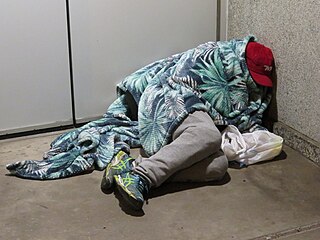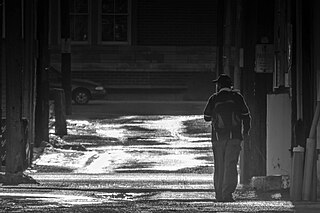Related Research Articles

King County is a county located in the U.S. state of Washington. The population was 2,269,675 in the 2020 census, making it the most populous county in Washington, and the 12th-most populous in the United States. The county seat is Seattle, also the state's most populous city.

Lennox is a census-designated place (CDP) in the South Bay region of Los Angeles County, California, United States. The population was 22,753 at the 2010 census, down from 22,950 at the 2000 census.

In the United States, the number of homeless people on a given night in January 2023 was more than 650,000 according to the Department of Housing and Urban Development. Homelessness has increased in recent years, in large part due to an increasingly severe housing shortage and rising home prices in the United States. Most homeless people lived in California, New York, Florida, and Washington in 2022, according to the annual Homeless Assessment Report. The majority of homeless people in the United States have been homeless for less than one year; two surveys by YouGov in 2022 and 2023 found that just under 20 percent of Americans reported having ever been homeless.

Homeless shelters are a type of service that provides temporary residence for homeless individuals and families. Shelters exist to provide residents with safety and protection from exposure to the weather while simultaneously reducing the environmental impact on the community.

Affordable housing is housing which is deemed affordable to those with a household income at or below the median, as rated by the national government or a local government by a recognized housing affordability index. Most of the literature on affordable housing refers to mortgages and a number of forms that exist along a continuum – from emergency homeless shelters, to transitional housing, to non-market rental, to formal and informal rental, indigenous housing, and ending with affordable home ownership. Demand for affordable housing is generally associated with a decrease in housing affordability, such as rent increases, in addition to increased homelessness.
Homeless Management Information System (HMIS) is a class of database applications used to confidentially aggregate data on homeless populations served in the United States. Such software applications record and store client-level information on the characteristics and service needs of homeless persons. An HMIS is typically a web-based software application that homeless assistance providers use to coordinate care, manage their operations, and better serve their clients.

Housing refers to the usage and possibly construction of shelter as living spaces, individually or collectively. Housing is a basic human need and a human right, playing a critical role in shaping the quality of life for individuals, families, and communities, As such it is the main issue of housing organization and policy.

Homelessness, also known as houselessness or being unhoused or unsheltered, is the condition of lacking stable, safe, and functional housing. It includes living on the streets, moving between temporary accommodation with family or friends, living in boarding houses with no security of tenure, and people who leave their homes because of civil conflict and are refugees within their country.

Discrimination against homeless people is categorized as the act of treating people who lack housing in a prejudiced or negative manner due to the fact that they are homeless. Other factors can compound discrimination against homeless people including discrimination on the basis of race, gender, sexuality, age, mental illness, and other considerations.

In the Seattle King County area, there were estimated to be 11,751 homeless people living on the streets or in shelters. On January 24, 2020, the count of unsheltered homeless individuals was 5,578. The number of individuals without homes in emergency shelters was 4,085 and the number of homeless individuals in transitional housing was 2,088, for a total count of 11,751 unsheltered people.
Perhaps the most accurate and current data on homelessness in the United States is reported annually by the Department of Housing and Urban Development (HUD) in the Annual Homeless Assessment Report to Congress (AHAR). The AHAR report relies on data from two sources: single-night, point-in-time counts of both sheltered and unsheltered homeless populations reported on the Continuum of Care applications to HUD; and counts of the sheltered homeless population over a full year provided by a sample of communities based on data in their local Homeless Management Information Systems (HMIS).

True Colors United is an American nonprofit organization addressing the issue of youth homelessness in the United States. Founded in 2008 by Cyndi Lauper, the organization focuses on the unique experiences of LGBT youth, who make up 40% of the homeless youth population in the United States.
Homeless veterans are persons who have served in the armed forces who are homeless or living without access to secure and appropriate accommodation.

Homelessness in the United States has differing rates of prevalence by state. The total number of homeless people in the United States fluctuates and constantly changes, hence a comprehensive figure encompassing the entire nation is not issued, since counts from independent shelter providers and statistics managed by the United States Department of Housing and Urban Development vary greatly. Federal HUD counts hover annually at around 500,000 people. Point-in-time counts are also vague measures of homeless populations and are not a precise and definitive indicator for the total number of cases, which may differ in both directions up or down. The most recent figure for 2019, was 567,715 individuals nationally that experienced homelessness at a point in time during this period.

Homelessness is a growing problem in Colorado and is considered the most important social determinants of health. Homelessness is very difficult for many Coloradoans to escape due to the continuous increase in costs for housing in Colorado, along with mental health treatments and other factors. When people are forced to live without stable shelter, they are then exposed to a number of risk factors that affect physical and mental health. Although it is difficult to pin point any one cause of homelessness, there is a complicated combination of societal and individual causes.

The United States Department of Housing and Urban Development estimated that more than 181,399 people were experiencing homelessness in California in January 2023. This is one of the highest per capita rates in the nation, with 0.46% of residents estimated as being homeless. More than two-thirds of homeless people in California are unsheltered, which is the highest percentage of any state in the United States. 49% of the unsheltered homeless people in the United States live in California. Even those who are sheltered are so insecurely, with 90% of homeless adults in California reporting that they spent at least one night unsheltered in the past six months.

In 2016, a report from the Department of Housing and Urban Development (HUD) revealed that the U.S. state of Oregon had an estimated homeless population of 13,238 with about 60.5% of these people still unsheltered. In 2017, these numbers were even higher. As of January 2017, Oregon has an estimated 13,953 individuals experiencing homelessness. Of this homeless population, 1,083 are family households, 1,251 are veterans, 1,462 are unaccompanied young adults, and 3,387 are individuals experiencing chronic homelessness. As of 2022, 17,959 people total experienced homelessness in Oregon, with 2,157 individuals being youth under 18, 6,671 being female, 10,931 being male, and 131 being transgender. Also among the 17,959 total homeless in 2022, 15,876 were Non-Hispanic/Non-Latino, 2,083 were Hispanic/Latino, 13,960 were white, 1,172 were Black, African American, or African, 101 were Asian or Asian American, 880 were Native American, and those of multiple race were 1,619. Oregon has seen an increase in its total homeless population consistently every year since 2010. In last three years specifically Oregon has seen a 98.5% increase 2021-2022, 22.5% increase 2020-2021, and a 13.1% increase 2019-2020.

Homelessness is a serious issue throughout the state of New Mexico. Through a demographic examination it becomes evident that New Mexico has a high proportion of ethnographies that are currently and historically socioeconomically disadvantaged. Native Americans as a proportion of the US population represent the second highest amongst all States with only Alaska having a higher ratio, while it also has a large Hispanic population. Homelessness is a direct cause from an individual not being able to provide themselves with the most basic of necessities to maintain a healthy life hence having a higher proportion of individuals in poverty places a greater risk of an individual becoming homeless.

The 2022 Annual Homelessness Assessment Report (AHAR) to Congress, produced by The U.S. Department of Housing and Urban Development, estimated that 10,654 Ohioans faced homelessness during the year, representing 9 in every 10,000 individuals. Over 80% of the homeless were sheltered. This population was made up of 3,214 people who belonged to families with children, 703 unaccompanied youth, 633 veterans, and 1,023 chronically homeless individuals.
Maine has one of the highest per capita rates of homelessness of any state within the East Coast of the United States. This may be attributed to several factors, including social issues that are more prevalent within New England.
References
- 1 2 "Don't Count on It: How the HUD Point-in-Time Count Underestimates the Homelessness Crisis in America" (PDF). National Law Center on Homelessness & Poverty. 2017. Archived (PDF) from the original on August 31, 2019. Retrieved August 1, 2019.
- ↑ Boone, Alastair (2019). "Is There a Better Way to Count the Homeless?". Bloomberg.com. CityLab. Archived from the original on August 1, 2019. Retrieved August 1, 2019.
- 1 2 "Point-in-Time Count Methodology Guide" (PDF). HUD. 2014. Archived (PDF) from the original on August 1, 2019. Retrieved August 1, 2019.
- ↑ "Solano County PIT Count Report". Simtech Solutions Inc. 2024. Retrieved October 15, 2024.
- ↑ "Point-in-Time (PIT) Count Standards and Methodologies Training". Archived from the original on January 18, 2021. Retrieved February 12, 2021.
- ↑ Cowan, Charles D.; Breakey, William R.; Fischer, Pamela J. (1988). "The Methodology of Counting the Homeless". Homelessness, Health, and Human Needs.